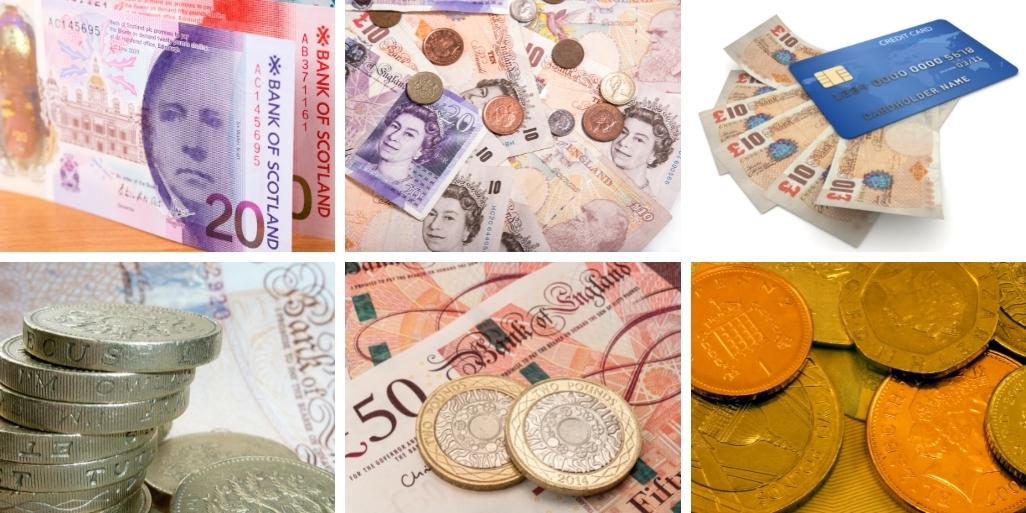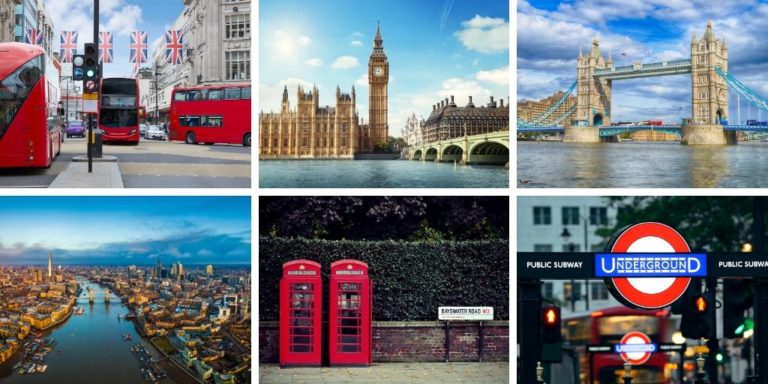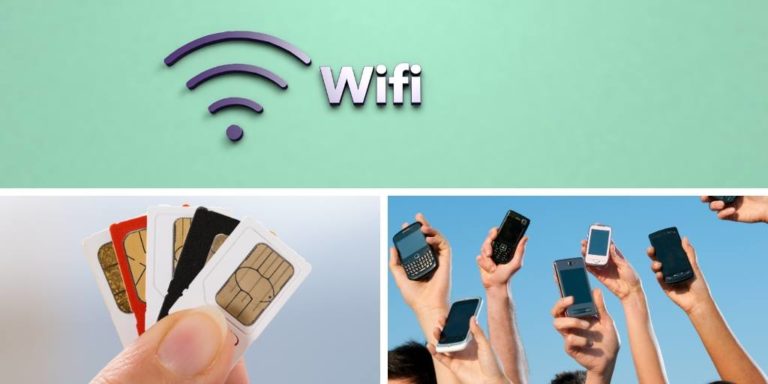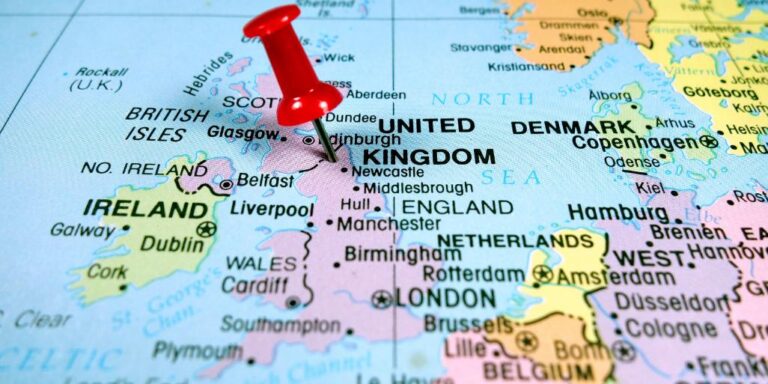How Should I Bring Money to the UK? A Complete Guide to Cash & Cards
Asking yourself how should I bring money to the UK when I visit? Discover the pros and cons of cash, contactless and cards plus answers to frequently asked questions.
There can be a considerable amount of confusion when it comes to spending money in the UK. As geographically the UK is part of Europe – and was historically part of the European Union (EU) – some people think that the UK currency is Euros.
But that’s not the case at all. Hence this post on how to bring money to the UK. The UK has its own currency, pounds sterling (written as GBP, Great British Pounds). And just to confuse visitors even more, although Scotland also uses pound sterling, Scottish cash looks completely different to English money.
This guide to using cash or cards in the UK will take you through all you need to know about spending money in the country. We’ll outline all the UK currency denominations you’ll find, as well as what happens when you cross the border into Scotland.
Also covered are all the pros and cons of using cash within the UK, as opposed to a credit or debit card plus why we choose to use a Wise card.
By the end of this guide, you’ll know all about UK currency and how best to use it. Let’s get stuck in by discussing the denominations British currency comes in.
- UK Travel Planning Podcast – Money Matters: Navigating Cash, Cards, and Currency in the UK
- Bank of England currency denominations
- Scottish currency denominations
- Northern Irish currency
- Pros and Cons of using Cash in the UK
- Pros and Cons of using Cards in the UK
- The Wise Card*
- How to Bring Money to the UK – FAQs
- Which way will you pay in the UK?
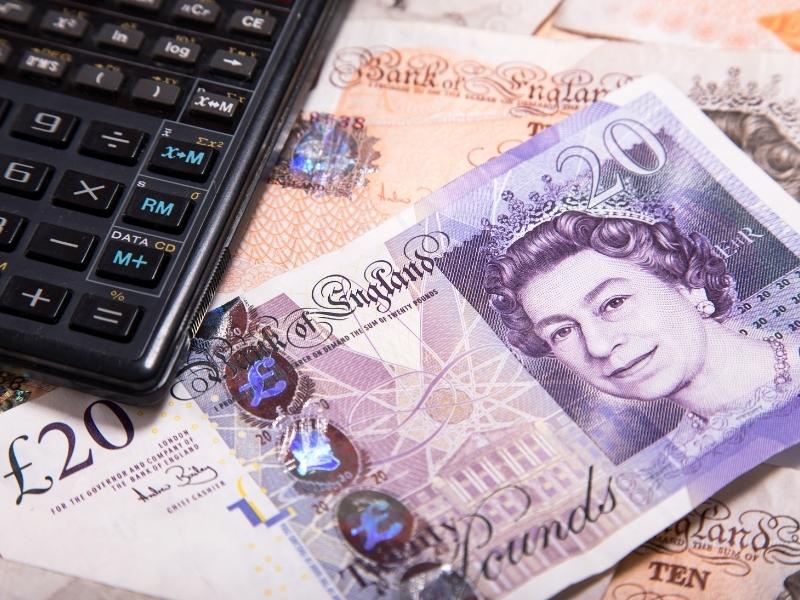

UK Travel Planning Podcast – Money Matters: Navigating Cash, Cards, and Currency in the UK
Bank of England currency denominations
There are currently four banknotes and eight coins in circulation in England and Wales. Let’s take a look at each in turn.
Banknotes
There are four different banknotes issued by the Bank of England – £5, £10, £20 or £50. There isn’t a £100 note.
Polymer banknotes have gradually replaced paper notes as they are more durable. Paper notes are no longer produced and aren’t legal tender anymore.
As of May 2023, all banknotes issued by the Bank of England feature the King’s portrait. However, banknotes featuring the late Queen Elizabeth II are still in circulation and are accepted as legal tender.
On the other side of a British banknote is a notable British historical figure. Below is some useful information about each note.
If you have visited the U.K before and still have some paper notes, you can exchange them for new polymer ones at selected post offices across the U.K. Alternatively, you can have the money electronically transferred into your bank account but only if it accepts GBP payments. You can find more information here.
£5 note
Often referred to as a ‘fiver’
- Colour: Aqua
- Portraits: The Queen & Sir Winston Churchill
The aqua coloured £5 note – or fiver – features a portrait of Sir Winston Churchill. He was a prominent Prime Minister who was in power during World War II. The historic paper version of the five pound note is no longer in circulation.
£10 note
Often referred to as a ‘tenner’
- Colour: Brown
- Portraits: The Queen & Jane Austen
The old paper £10 note is no longer legal tender. A new brown polymer note features Jane Austen, the famous British writer who published Pride and Prejudice, among other works.
£20 note
Often referred to as a ‘twenty’
- Colour: Purple
- Portraits: The Queen & JMW (William) Turner
As of 2022, paper £20 notes aren’t legal tender anymore. If you have one, you can’t use it for payment at a retailer.
The English Romantic artist J. M. W. Turner is featured on the new purple £20 notes.
A £20 note is sometimes simply called ‘a twenty’, though it’s not as commonly heard a term as ‘fiver’ or ‘tenner’. In some parts of London, you may hear the cockney slang term ‘score’ used for a £20 note.
£50 note
Often referred to as a ‘fifty’
- Colour: Red
- Portraits: The Queen & Alan Turing
Paper £50 notes are no longer legal tender. The new polymer ‘fifty’ note is red and features Alan Turing, a mathematician credited as the founder of modern computing. He is also known for his work in devising code breaking machines during World War II.


Coins
Note that with coins, the ‘p’ means pence and there are 100 pence in each pound.
‘Coppers’: 1p and 2p
These coins are round with 1p being smaller than a 2p coin.
Silver coins: 5p, 10, 20p, 50p.
5p and 10p coins are round (5p is smaller than 10p). Both the small 20p coin and the larger 50p coin have seven sides, a shape known as equilateral curve heptagon.
£1 & £2
These different sized coins are round with a silver centre (made from cupro-nickel) with a yellow edge (made from brass-nickel).
All coins feature the King’s (or late Queen’s) portrait, and special editions are often minted. It’s worth checking your coins in case you have a special edition coin as they can be worth more than their face value.
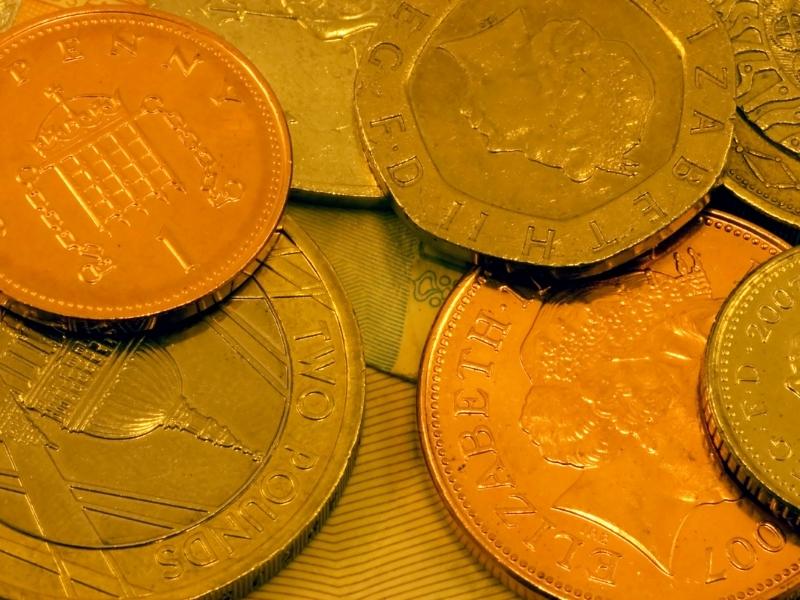

Scottish currency denominations
- Notes: £1, £5, £10, £20, £50 and £100 (issued by 3 Scottish banks)
- Coins: same as England, Wales & Northern Ireland
As mentioned in the introduction, Scotland does things its own way – and not least when it comes to money.
The coins are exactly the same as the English versions, and both coins and banknotes have the same denominations. However, Scottish banknotes look different as they have different features and pictures. Paper notes are no longer legal tender in Scotland.
Three Scottish banks issue notes – the Bank of Scotland, Clydesdale Bank and the Royal Bank of Scotland. Each uses unique designs.
In theory, both Bank of England and Scottish banknotes are accepted across the UK as both state ‘pounds sterling’ on them. But in practice some retailers in England aren’t keen on accepting Scottish notes. This is less of an issue in places close to the border like Edinburgh or Northumberland, or in major tourist centres.
This confusion can be avoided by using credit or debit cards.
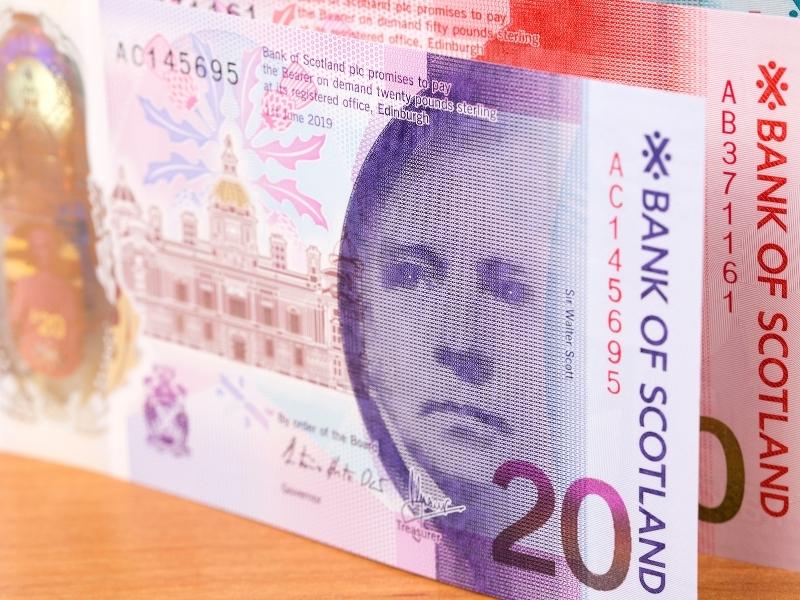

Northern Irish currency
We also need to mention Northern Ireland. Northern Ireland also issues its own pound sterling banknotes, that are the same in value as the English and Scottish ones.
While (in theory at least) you can use Northern Ireland notes worth £5 or more anywhere in the UK, you’ll find most places in England unwilling to accept them.
However, you’re much more likely to come across English banknotes in Northern Ireland than Northern Irish notes. English banks will exchange them if you have an English bank account or you can exchange them directly at the Bank of England in London.
Note that if you are crossing the border into the Republic of Ireland, you’ll need Euros.
Pros and Cons of using Cash in the UK
So now you know what the money is all about, here are some reasons why you might want – or not want – to use cash in the UK.
Pros
- It’s simple to budget on a daily basis
- It’s easy to keep track of your spending
- It may be useful for car parking, tipping and small purchases
- A banknote makes a cool souvenir of your time in the UK
- You can change money at banks, post offices, hotels & bureaus de change
- Some retailers may only accept cash for small transactions or transactions under £5.
Cons
- Some UK outlets are now cashless
- Changing money takes up valuable time
- Cash is more bulky to carry than one or two cards
- It can be confusing, especially when travelling in Scotland
- Lost or stolen cash can be more difficult to claim on your insurance
If you need to change foreign currency into GBP, use a travel exchange in a high street bank or in a Post Office. Some UK supermarkets such as Asda and Tesco and larger department stores such as Marks and Spencers also have currency exchange facilities. Avoid changing money at the airport as they usually offer the worst rates.
Pros and Cons of using Cards in the UK
So what about credit and debit cards, or other types of payment cards? Big names like Visa and Mastercard are accepted all over the UK. American Express cards are not as widely accepted as Visa and Mastercard. Apple Pay and Google Pay are also widely accepted in the UK.
You should use your card for large purchases rather than for withdrawing cash. Unlike card purchases, if you use your card to withdraw cash, interest will apply from the date a cash transaction is made. You might also be charged cash transaction fees in addition to exchange fees.
Remember, if the card machine or retailer asks if you want to pay in your home currency or in pound sterling, choose pound sterling. If you don’t, you’ll be charged an unknown exchange fee and will likely get an unfavourable exchange rate. Always pay in GBP (local currency).
Here’s some more information on the pros and cons of paying by card, whether it’s a physical card or on a device.
Pros
- No need to change money
- You’re prepared for cashless payments
- Mastercard and Visa are widely accepted
- Cards are very lightweight and easy to carry
- There’s no confusion between Scottish and Bank of England notes
- If you need to withdraw cash, you’ll find ATM’s everywhere – in shops, supermarkets, and stations.
Cons
- It can be harder to budget
- Tracking your spending is more difficult
- You may not be able to use cards for small transactions or for tipping
- You may have to cancel a stolen or lost card from another country
- Card fees can be high and exchange rates unfavourable on standard credit cards which are not aimed at travellers.
- Some ATM’s charge fees (the ATM screen should state if withdrawals are free or not)
If you choose to use a credit or debit card, try to use one aimed at international travellers. You’ll pay less fees, will usually get the current exchange rate and may get other added bonuses such as insurance. Whichever card you choose to use, make sure you read the small print about using your card abroad.
You can also use a pre-loaded card such as Revolut or cards specifically designed for foreign transactions, such as our favoured Wise card.
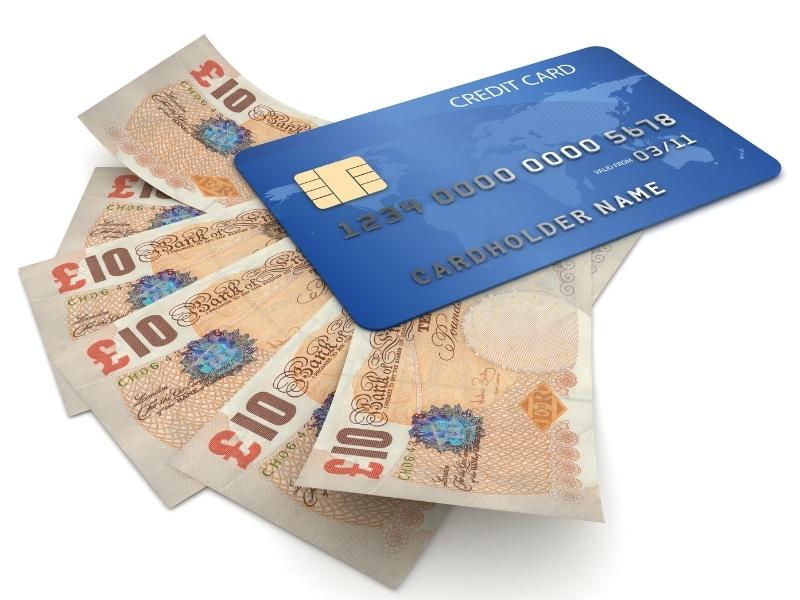

The Wise Card*
*Advice given in this article is general in nature and is not intended to influence readers’ decisions about investing or financial products. You should always seek your own professional advice that takes into account your personal circumstances before making any financial decisions. We always encourage our readers to compare options when it comes to financial products. Read our full disclosure.
The Wise Card comes from Wise, an international payment and transfer platform. Wise was set up to offer simple, lightning-fast and low-cost transactions.
The Wise Mastercard is available to anyone with a Wise account, including citizens of countries like the US, New Zealand, Australia and Europe. You’ll need a multi-currency Wise account to apply for the card.
A Wise card works like a debit card. This means that if there’s money in your Wise account, you can spend it anywhere Mastercard is accepted. You can pay via Wise in more than 50 currencies worldwide. A set amount of money can also be withdrawn in cash, and this varies by country.
It’s free to open a Wise account, and then you can apply for the card. This will open the door to spending money all over the world – without any unreasonable fees or poor exchange rates.
The rates compare very favourably to the likes of PayPal, which is why anyone who gets paid from another country tends to fall in love with Wise and its low fees!
Note that if you are interested in getting a Wise card for your trip, organise it several weeks in advance as it can take a couple of weeks to organise.
“From a personal perspective, we love Wise – and so do the freelancers and partners we work with in the UK and Australia.”
Wise Card Pros and Cons
Pros
- A Wise account – and card – is free. There are no monthly fees.
- Wise fees are lower than fees charged by banks
- Wise offers more favourable exchange rates than the likes of PayPal
- There are good security features to protect users
- You can use Wise like a debit card or to withdraw cash
- It’s available in over 60 countries
- You can get a virtual card as well as a plastic one
Cons
- The Wise card isn’t yet available in many countries
- You’ll need funds in your account to pay with or withdraw
- There are limits as to how much cash you can withdraw via the card (though withdrawals are free)
Find out more about the Wise card here.
How to Bring Money to the UK – FAQs
Do I need to bring cash to the UK?
It’s a good idea to have small amounts of cash when travelling in the U.K. You may need coins or notes for parking meters or for tipping. When paying for small items it can also be simpler to hand over a few coins than a card or a banknote.
Although many car parks in the UK now use parking apps for parking charges, we needed to use cash for parking on more than one occasion during our recent trip. Some taxis may also accept only cash, especially outside the major cities.
Some smaller retailers only accept cash for purchases under £5 so it’s a good idea to carry some loose cash with you at all times.
Should I do anything before paying by card in the UK?
If you’re planning a UK trip, it’s best to tell your bank that you’ll be travelling and where you’re travelling to before you use your card overseas. Otherwise they may suspect fraud and block your card.
Always read the small print on your credit card agreement so you know what to expect if you use it abroad.
Consider shopping around for a credit card that offers more benefits for foreign travel.
Do I need to bring more than one card?
It’s always a good idea to travel with more than one payment card, just in case one is lost, stolen or blocked. One Mastercard and one Visa card, for example, would be a good bet.
You may also need a second card if the first type isn’t accepted in the places in which you stay, eat or shop. Visa and Mastercard are accepted in more places than American Express.
Don’t rely on your phone as your sole payment method. Bring an additional physical card just in case you lose or damage your phone or have a dead battery.
Can I pay with US dollars in the UK?
US dollars are not accepted in the UK as a form or payment. Euros are not accepted either. With the exception of places like airport stores, you’ll need to use UK currency in cash or a payment card during your time in the UK.
Which way will you pay in the UK?
In most cases, paying by card is more convenient than cash, though we always recommend carrying a small amount of cash for parking, taxis, small purchases and tips.
Ideally, take a Wise Mastercard and a Visa debit or credit card with you – plus a small amount of cash. That way you’ll be covered every single time you need to pay for something.
For more on paying your way in London, don’t miss this article on Oyster Cards versus contactless payments.

